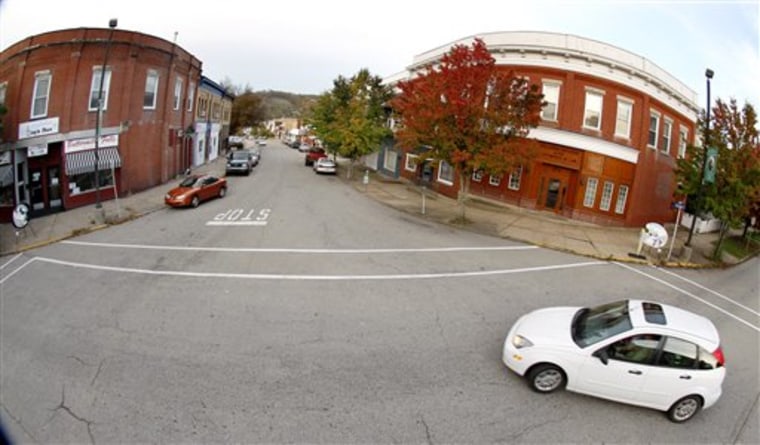Imagine: It's 1895. A steel baron hires New York's Central Park designer Frederick Law Olmsted to build a town in western Pennsylvania where mill workers can live, work and play. By the turn of the century, Vandergrift's rounded buildings and roads flow along the contours of the Kiskiminetas River.
Reality: Pretty much all that's left of that town is in the imagination.
So 114 years later, Vandergrift residents — from baby boomers who grew up during the town's heyday to students as young as their grandchildren — are reviving Olmsted's vision and making the community environmentally sustainable for the 21st century and beyond.
Their goal is to attract people to live or shop in the boutiques of the quaint town of just 5,000 people — which lost residents, jobs and allure along with steel.
From bringing back green spaces paved-over for parking to seeking how to harness electrical energy for the town from the fast-flowing river, Vandergrift is investing millions toward environmentally sustainable revitalization — a concept gaining popularity in Rust Belt towns that have few viable options for renewal.
"This community is such a wonderful template for demonstrating (sustainability) not just for themselves, but, I think, way outside of Vandergrift," said University of Pittsburgh professor Lisa Mauck Weiland, looking over the skeletal wooden remains of what was once a JCPenney. The building is now the object of a "green" renovation with the input of students from Pitt and a local high school.
While many communities are embracing sustainable revitalization, Vandergrift's strategy is all-encompassing: to create an energy independent, ecologically low-impact, economically viable town from the ashes of its postindustrial wasteland. It aims to renovate buildings with sustainable materials, from carpet textiles to solar roof panels. A farmers market has been expanded. Trees are being planted and green spaces recovered.
Perhaps the most ambitious is the river energy project. With Weiland's guidance and a grant from the National Science Foundation, University of Pittsburgh students are seeking to exploit the hydrokinetic forces of the Kiski River to offset energy costs downtown, without building dams or coal-burning electrical facilities.
Sustainability fits Vandergrift well. Olmsted, known as the father of American landscape architecture, made the town's design one with nature — the philosophy he used when planning the U.S. Capital grounds, the lush green campuses of Boston and Stanford universities, Central Park's 843 acres of woodlands, lawns and ponds — as well as distinctive parks in Boston, Detroit, Milwaukee, Chicago, Atlanta, Louisville, Ky., and Buffalo, N.Y.
Olmsted's theory was that every urbanite, regardless of status, needed a sanctuary. He designed Vandergrift, 35 miles northeast of Pittsburgh, with no right angles, instead following the curves of the river. He also used curving paths to blur movement among pedestrians and hedges to buffer commercialism. Street corners and the buildings on them were rounded. Parks dotted the hilly landscape, and the town was walkable.
"The town is set up and has the same layout as Olmsted designed it," said Ashley Bistline, a 17-year-old senior at Kiski Area High School, who is participating in the JCPenney renovation. "That in itself is enough of an attraction."
The decrepit former department store is not unusual. Many original buildings are in disrepair. Urban islands of grass and flowers are now concrete parking lots. Vacant storefronts and boarded-up buildings dot a main street that is just a whiff of the packed sidewalks, restaurants and boutiques of yesteryear.
Like most other Pittsburgh-area Rust Belt towns, Vandergrift's fortunes dissolved along with the steel industry. In 28 years, the town's population dropped from more than 6,800 in 1980 to barely 5,000 in 2008. By 2000, a quarter of the residents were over 65 and almost 16 percent lived in poverty — about 4 percent higher than the national average.
Memory runs deep in a town with a high elderly population. In the late 1980s a group formed to oppose demolition of the Casino Theater, built in 1900 to feature vaudeville shows. Volunteering labor and funding, they renovated the Greek Revival-style building where school shows and occasionally movies are now featured as the lobby is redone.
Since then, a flower shop has filled a fully restored main street facade, other construction is under way, and the idea of creating downtown residences is being explored.
Meade Jack, president of the Vandergrift Improvement Program, wants sustainable concepts throughout downtown, beginning with the JCPenney — a building the size of four NBA basketball courts — that will get a nearly $2 million, five-year "sustainable" renovation.
"I think a lot of people have forgotten about it. They've written it out of their lives," Bistline said. "That's why we're doing the project, to bring people back to the town."
